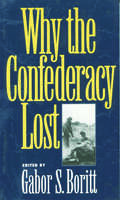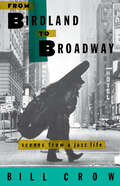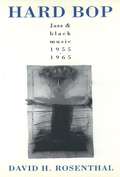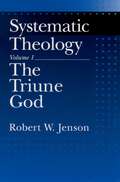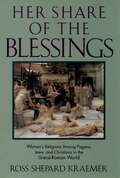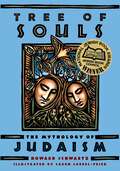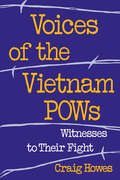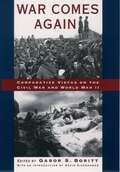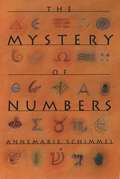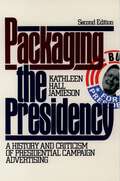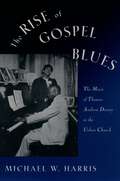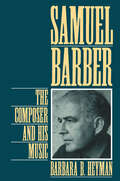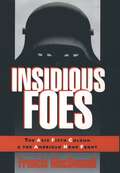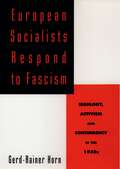- Table View
- List View
Strategic Management for Nonprofit Organizations: Theory and Cases
by Sharon M. OsterNonprofit organizations in the U.S. earn more than $100 billion annually, and number over a million different organizations. They face increasing competition for donor's dollars and many of the issues they confront are similar to those confronted by for-profit organizations. Strategic Management for Nonprofit Organizations applies powerful concepts of strategic management developed originally in the for-profit sector to the management of nonprofits. It describes the preparation of a strategic plan consistent with the resources available; it analyzes the operational tasks in executing the plan; and describes the ways in which nonprofits need to change in order to remain competitive. The book draws clear distinctions between the different challenges encountered by nonprofits operating in different industries.
Why the Confederacy Lost (Gettysburg Civil War Institute Books)
by Gabor S. BorittAfter the Civil War, someone asked General Pickett why the Battle of Gettysburg had been lost: Was it Lee's error in taking the offensive, the tardiness of Ewell and Early, or Longstreet's hesitation in attacking? Pickett scratched his head and replied, "I've always thought the Yankees had something to do with it." This simple fact, writes James McPherson, has escaped a generation of historians who have looked to faulty morale, population, economics, and dissent as the causes of Confederate failure. These were all factors, he writes, but the Civil War was still a war--won by the Union army through key victories at key moments. With this brilliant review of how historians have explained the Southern defeat, McPherson opens a fascinating account by several leading historians of how the Union broke the Confederate rebellion. In every chapter, the military struggle takes center stage, as the authors reveal how battlefield decisions shaped the very forces that many scholars (putting the cart before the horse) claim determined the outcome of the war. Archer Jones examines the strategy of the two sides, showing how each had to match its military planning to political necessity. Lee raided north of the Potomac with one eye on European recognition and the other on Northern public opinion--but his inevitable retreats looked like failure to the Southern public. The North, however, developed a strategy of deep raids that was extremely effective because it served a valuable political as well as military purpose, shattering Southern morale by tearing up the interior. Gary Gallagher takes a hard look at the role of generals, narrowing his focus to the crucial triumvirate of Lee, Grant, and Sherman, who towered above the others. Lee's aggressiveness may have been costly, but he well knew the political impact of his spectacular victories; Grant and Sherman, meanwhile, were the first Union generals to fully harness Northern resources and carry out coordinated campaigns. Reid Mitchell shows how the Union's advantage in numbers was enhanced by a dedication and perseverance of federal troops that was not matched by the Confederates after their home front began to collapse. And Joseph Glatthaar examines black troops, whose role is entering the realm of national myth. In 1960, there appeared a collection of essays by major historians, entitled Why the North Won the Civil War, edited by David Donald; it is now in its twenty-sixth printing, having sold well over 100,000 copies. Why the Confederacy Lost provides a parallel volume, written by today's leading authorities. Provocatively argued and engagingly written, this work reminds us that the hard-won triumph of the North was far from inevitable.
From Birdland to Broadway: Scenes from a Jazz Life
by Bill CrowIn the 1950s, New York City's Birdland was the center of the world of modern jazz--and a revelation to Bill Crow, a wet-behind-the-ears twenty-two-year-old from Washington State. Located on Broadway between 52nd and 53rd streets, the club named for the incomparable Charlie "Bird" Parker boasted lifesize photo murals of modern jazzmen like Dizzy Gillespie, Lennie Tristano, and, of course, Bird himself, looming large against jet black walls. Exotic live birds perched in cages behind the bar. The midget master of ceremonies, 3'9" Pee Wee Marquette, dressed in a zoot suit and loud tie, smoked huge cigars and screeched mispronounced introductions into the microphone. And the jazz-struck young Crow would park in the bleachers till 4 am, blissfully enveloped by the heady music of Bird, Bud Powell, Max Roach, and a host of other jazz giants. From Birdland to Broadway is an enthralling insider's account of four decades of a life in jazz. Bill Crow, journeyman bass player, superb storyteller, and author of the successful Jazz Anecdotes, here narrates many moving and delightful tales of the pioneers of modern jazz he played with and was befriended by. We find Dizzy Gillespie, with whom Crow, because of prior commitments, regretfully declined steady work, dancing at the Royal Roost, Stan Getz sadly teetering on the brink of losing himself to drugs, and Harry Belafonte (known then as "the Cinderella Gentleman") running a lunch counter in New York's Sheridan Square between music dates. And we also witness many of the highlights of Crow's career, such as in 1955 when the Marian McPartland Trio (with Crow on bass) was named "Small Group of the Year" by Metronome; Crow playing with the Gerry Mulligan Quartet at venues like Storyville in Boston and Harlem's Apollo Theater (where they appeared with Dinah Washington); and the tour of the Soviet Union with Benny Goodman, a journey that might have been a high point of Crow's travels abroad but was marred by Goodman's legendary mistreatment of his band. Moving beyond jazz clubs to the Broadway concert pit and a variety of studio gigs in the '60s, Crow encounters actors such as Yul Brynner and pop-rock acts like Simon and Garfunkel. From the great to the near-great, from Billie Holiday to Judy Holliday, Bill Crow's wealth of personal anecdotes takes the reader from Birdland, to the Half Note, to the Playboy Club, to the footlights of Broadway. This revealing book is a marvelous portrait of the jazz world, told by someone who's been there.
Hard Bop: Jazz and Black Music 1955-1965
by the late David H. RosenthalIt's nineteen fifty-something, in a dark, cramped, smoke-filled room. Everyone's wearing black. And on-stage a tenor is blowing his heart out, a searching, jagged saxophone journey played out against a moody, walking bass and the swish of a drummer's brushes. To a great many listeners--from African American aficionados of the period to a whole new group of fans today--this is the very embodiment of jazz. It is also quintessential hard bop. In this, the first thorough study of the subject, jazz expert and enthusiast David H. Rosenthal vividly examines the roots, traditions, explorations and permutations, personalities and recordings of a climactic period in jazz history. Beginning with hard bop's origins as an amalgam of bebop and R&B, Rosenthal narrates the growth of a movement that embraced the heavy beat and bluesy phrasing of such popular artists as Horace Silver and Cannonball Adderley; the stark, astringent, tormented music of saxophonists Jackie McLean and Tina Brooks; the gentler, more lyrical contributions of trumpeter Art Farmer, pianists Hank Jones and Tommy Flanagan, composers Benny Golson and Gigi Gryce; and such consciously experimental and truly one-of-a-kind players and composers as Andrew Hill, Sonny Rollins, John Coltrane, Thelonious Monk, and Charles Mingus. Hard bop welcomed all influences--whether Gospel, the blues, Latin rhythms, or Debussy and Ravel--into its astonishingly creative, hard-swinging orbit. Although its emphasis on expression and downright "badness" over technical virtuosity was unappreciated by critics, hard bop was the music of black neighborhoods and the last jazz movement to attract the most talented young black musicians. Fortunately, records were there to catch it all. The years between 1955 and 1965 are unrivaled in jazz history for the number of milestones on vinyl. Miles Davis's Kind of Blue, Charles Mingus's Mingus Ah Um, Thelonious Monk's Brilliant Corners, Horace Silver's Further Explorations--Rosenthal gives a perceptive cut-by-cut analysis of these and other jazz masterpieces, supplying an essential discography as well. For knowledgeable jazz-lovers and novices alike, Hard Bop is a lively, multi-dimensional, much-needed examination of the artists, the milieus, and above all the sounds of one of America's great musical epochs.
Drug Delivery: Engineering Principles for Drug Therapy (Topics in Chemical Engineering)
by W. Mark SaltzmanSynthetic materials are a tremendous potential resource for treating human disease. For the rational design of many of these biomaterials it is necessary to have an understanding of polymer chemistry and polymer physics. Equally important to those two fields is a quantitative understanding of the principles that govern rates of drug transport, reaction, and disappearance in physiological and pathological situations. This book is a synthesis of these principles, providing a working foundation for those in the field of drug delivery. It covers advanced drug delivery and contemporary biomaterials.
Systematic Theology: Volume 2: The Works of God
by Robert W. JensonSystematic Theology is the capstone of Robert Jenson's long and distinguished career as a theologian, being a full-scale systematic/dogmatic theology in the classic format. This is the second and concluding volume of the work. Here, Jenson considers the works of God, examining such topics as the nature and role of the Church, and God's works of creation.
Her Share of the Blessings: Women's Religions Among Pagans, Jews, And Christians In The Greco-roman World
by Ross Shepard KraemerHer Share of the Blessings: Women's Religions among Pagans, Jews, and Christians in the Greco-Roman World
by Ross Shepard KraemerIn this pathbreaking volume, Ross Shepard Kraemer provides the first comprehensive look at women's religions in Greco-Roman antiquity. She vividly recreates the religious lives of early Christian, Jewish, and pagan women, with many fascinating examples: Greek women's devotion to goddesses, rites of Roman matrons, Jewish women in rabbinic and diaspora communities, Christian women's struggles to exercise authority and autonomy, and women's roles as leaders in the full spectrum of Greco-Roman religions. In every case, Kraemer reveals the connections between the social constraints under which women lived, and their religious beliefs and practices. The relationship among female autonomy, sexuality, and religion emerges as a persistent theme. Analyzing the monastic Jewish Therapeutae and various Christian communities, Kraemer demonstrates the paradoxical liberation which women achieved by rejection of sexuality, the body, and the female. In the epilogue, Kraemer pursues the disturbing implications such findings have for contemporary women. Based on an astonishing variety of primary sources, Her Share of the Blessings is an insightful work that goes beyond the limitations of previous scholarship to provide a more accurate portrait of women in the Greco-Roman world.
Tree of Souls: The Mythology of Judaism
by Howard SchwartzThe first anthology of Jewish mythology in English, Tree of Souls reveals a mythical tradition as rich and as fascinating as any in the world. Drawing from the Bible, the Pseudepigrapha, the Talmud and Midrash, the kabbalistic literature, medieval folklore, Hasidic texts, and oral lore collected in the modern era, Schwartz has gathered together nearly 700 of the key Jewish myths. The myths themselves are marvelous. We read of Adams diamond and the Land of Eretz (where it is always dark), the fall of Lucifer and the quarrel of the sun and the moon, the Treasury of Souls and the Divine Chariot. We discover new tales about the great figures of the Hebrew Bible, from Adam to Moses; stories about God's Bride, the Shekhinah, and the evil temptress, Lilith; plus many tales about angels and demons, spirits and vampires, giant beasts and the Golem. Equally important, Schwartz provides a wealth of additional information. For each myth, he includes extensive commentary, revealing the source of the myth and explaining how it relates to other Jewish myths as well as to world literature (for instance, comparing Eves release of evil into the world with Pandoras). For ease of use, Schwartz divides the volume into ten books, Myths of God, Myths of Creation, Myths of Heaven, Myths of Hell, Myths of the Holy Word, Myths of the Holy Time, Myths of the Holy People, Myths of the Holy Land, Myths of Exile, and Myths of the Messiah.
War Comes Again: Comparative Vistas on the Civil War and World War II (Gettysburg Civil War Institute Books)
by Gabor S. BorittThe Civil War and the World War II stand as the two great cataclysms of American history. They were our two costliest wars, with well over a million casualties suffered in each. And they were transforming moments in our history as well, times when the life of the nation and the great experiment in democracy--government of the people, by the people, for the people--seemed to hang in the balance. Now, in War Comes Again, eleven eminent historians--including three Pulitzer Prize winners, all veterans of the Second World War--offer an illuminating comparison of these two epic events in our national life. The range of essays here is remarkable, the level of insight consistently high, and the quality of the writing is superb. For instance, Stephen Ambrose, the bestselling author of D-Day, June 6th, 1944, offers an intriguing comparison of the two great military leaders of each war--Grant and Eisenhower. Pulitzer Prize-winning historian Robert V. Bruce takes a revealing look at the events that foreshadowed the two wars. Gerald Linderman, author of Embattled Courage, examines the two wars from the point of view of the combat soldier. And Arthur Schlesinger, Jr., describes how both Lincoln and FDR went around strict observance of the Constitution in order to preserve the Constitution. There is, in addition, a fascinating discussion of the crucial role played by spying during the two wars, by Peter Maslowski; a look at the diplomacy of Lincoln and Roosevelt, by Howard Jones; and essays on the impact of the wars on women and on African Americans, by D'Ann Campbell, Richard Jensen, and Ira Berlin. In perhaps the most gripping piece in the book, Michael C.C. Adams offers an unflinching look at war's destructiveness, as he argues that the evils we associate with "bad wars" (such as Vietnam) are equally true of "good wars." And finally, in perhaps the most provocative essay in the book, Russell Weigley, one of America's most eminent military historians, maps the evolution of American attitudes toward war to our present belief that the only acceptable war is one that is short, inexpensive, and certain of victory. Would any great commander, Weigley asks, would a Lee or a Grant or a Marshall, refuse to fight unless he knew he couldn't lose? "Is not a willingness to run risks for the sake of cherished values and interests close to the heart of what defines greatness in a human being or in a nation?" Another Pulitzer winner and World War II veteran, Don E. Fehrenbacher, concludes War Comes Again with a very personal look at two common soldiers who have no monuments, who have not been mentioned in previous histories, but who point at the essence of these two wars and are "embedded in the very structure of the enduring nation and the world we live in."
The Mystery of Numbers
by Annemarie SchimmelWhy is the number seven lucky--even holy--in almost every culture? Why do we speak of the four corners of the earth? Why do cats have nine lives (except in Iran, where they have seven)? From literature to folklore to private superstitions, numbers play a conspicuous role in our daily lives. But in this fascinating book, Annemarie Schimmel shows that numbers have been filled with mystery and meaning since the earliest times, and across every society. In The Mystery of Numbers Annemarie Schimmel conducts an illuminating tour of the mysteries attributed to numbers over the centuries. She begins with an informative and often surprising introduction to the origins of number systems: pre-Roman Europeans, for example, may have had one based on twenty, not ten (as suggested by the English word "score" and the French word for 80, quatrevingt --four times twenty), while the Mayans had a system more sophisticated than our own. Schimmel also reveals how our fascination with numbers has led to a rich cross-fertilization of mathematical knowledge: "Arabic" numerals, for instance, were picked up by Europe from the Arabs, who had earlier adopted them from Indian sources ("Algorithm" and "algebra" are corruptions of the Arabic author and title names of a mathematical text prized in medieval Europe). But the heart of the book is an engrossing guide to the symbolism of numbers. Number symbolism, she shows, has deep roots in Western culture, from the philosophy of the Pythagoreans and Platonists, to the religious mysticism of the Cabala and the Islamic Brethren of Purity, to Kepler's belief that the laws of planetary motion should be mathematically elegant, to the unlucky thirteen. After exploring the sources of number symbolism, Schimmel examines individual numbers ranging from one to ten thousand, discussing the meanings they have had for Judaic, Christian, and Islamic traditions, with examples from Indian, Chinese, and Native American cultures as well. Two, for instance, has widely been seen as a number of contradiction and polarity, a number of discord and antithesis. And six, according to ancient and neo-platonic thinking, is the most perfect number because it is both the sum and the product of its parts (1+2+3=6 and 1x2x3=6). Using examples ranging from the Bible to the Mayans to Shakespeare, she shows how numbers have been considered feminine and masculine, holy and evil, lucky and unlucky. A highly respected scholar of Islamic culture, Annemarie Schimmel draws on her vast knowledge to paint a rich, cross-cultural portrait of the many meanings of numbers. Engaging and accessible, her account uncovers the roots of a phenomenon we all feel every Friday the thirteenth.
Packaging the Presidency: A History And Criticism Of Presidential Campaign Advertising
by Kathleen Hall JamiesonPackaging The Presidency: A History and Criticism of Presidential Campaign Advertising
by Kathleen Hall JamiesonPackaging the Presidency, Third Edition, is now completely updated to offer the only comprehensive study of the history and effects of political advertising in the United States. Noted political critic Kathleen Hall Jamieson traces the development of presidential campaigning from early political songs and slogans through newsprint and radio, and up to the inevitable history of presidential campaigning on television from Eisenhower to Clinton. The book also covers important issues in the debate about political advertising by touching on the development of laws governing political advertising, as well as how such advertising reflects, and at the same time helps to create, the nature of the American political office. Finally, current public concerns about political advertising are addressed as Jamieson raises the topic of ads dealing mainly in images rather than issues, and of political aspirations becoming increasingly only for the rich, who can afford the enormous cost of television advertising.
Policing the Globe: Criminalization and Crime Control in International Relations
by Peter Andreas Ethan NadelmannIn this illuminating history that spans past campaigns against piracy and slavery to contemporary campaigns against drug trafficking and transnational terrorism, Peter Andreas and Ethan Nadelmann explain how and why prohibitions and policing practices increasingly extend across borders. The internationalization of crime control is too often described as simply a natural and predictable response to the growth of transnational crime in an age of globalization. Andreas and Nadelmann challenge this conventional view as at best incomplete and at worst misleading. The internationalization of policing, they demonstrate, primarily reflects ambitious efforts by generations of western powers to export their own definitions of "crime," not just for political and economic gain but also in an attempt to promote their own morals to other parts of the world. A thought-provoking analysis of the historical expansion and recent dramatic acceleration of international crime control, Policing the Globe provides a much-needed bridge between criminal justice and international relations on a topic of crucial public importance.
The Rise of Gospel Blues: The Music of Thomas Andrew Dorsey in the Urban Church
by Michael W. HarrisMost observers believe that gospel music has been sung in African-American churches since their organization in the late 1800s. Yet nothing could be further from the truth, as Michael W. Harris's history of gospel blues reveals. Tracing the rise of gospel blues as seen through the career of its founding figure, Thomas Andrew Dorsey, Harris tells the story of the most prominent person in the advent of gospel blues. Also known as "Georgia Tom," Dorsey had considerable success in the 1920s as a pianist, composer, and arranger for prominent blues singes including Ma Rainey. In the 1930s he became involved in Chicago's African-American, old-line Protestant churches, where his background in the blues greatly influenced his composing and singing. Following much controversy during the 1930s and the eventual overwhelming response that Dorsey's new form of music received, the gospel blues became a major force in African-American churches and religion. His more than 400 gospel songs and recent Grammy Award indicate that he is still today the most prolific composer/publisher in the movement. Delving into the life of the central figure of gospel blues, Harris illuminates not only the evolution of this popular musical form, but also the thought and social forces that forged the culture in which this music was shaped.
Samuel Barber: The Composer and His Music
by Barbara B. HeymanSamuel Barber (1910-1981) was one of the most important and honored American composers of the twentieth century. Writing in a great variety of musical forms--symphonies, concertos, operas, vocal music, and chamber music--he infused his works with poetic lyricism and gave tonal language and forms new vitality. His rich legacy includes such famous compositions as the Adagio for Strings, the orchestral song Knoxville: Summer of 1915, three concertos, and his two operas, the Pulitzer Prize-winning Vanessa and Antony and Cleopatra, a commissioned work that opened the new Metropolitan Opera House at Lincoln Center. Generously documented by letters, sketchbooks, original musical manuscripts, and interviews with friends, colleagues and performers with whom he worked, this is the first book to cover Barber's entire career and all of his compositions. The biographical material on Barber is closely interspersed with a discussion of his music, displaying Barber's creative processes at work from his early student compositions to his mature masterpieces. Heyman also provides the social context in which this major composer grew: his education, how he built his career, the evolving musical tastes of American audiences, his relationship to musical giants like Serge Koussevitzky, and the role of radio in the promotion of his music. A testament to the significance of the new Romanticism, Samuel Barber stands as a model biography of an important American musical figure.
Insidious Foes: The Axis Fifth Column and the American Home Front
by Francis MacDonnellNazi Germany's efforts to weaken the United States by subversion failed miserably. Bungling spies were captured and half-hearted efforts at sabotage came to nothing. Yet anyone who lived through WWII remembers the chilling posters warning Americans that "Enemy Agents Have Big Ears" and "Loose Lips Sink Ships." Even Superman joined the struggle against these insidious foes. In 1940, polls showed that 71% of Americans believed a Nazi Fifth Column had penetrated the country. Almost half were convinced that spies, saboteurs, dupes, and rumor-mongers lurked in their own neighborhoods and work-places. These fears extended to the White House and Congress. In this book, Francis MacDonnell explains the origins and consequences of America's Fifth Column panic, arguing that conviction and expedience encouraged President Roosevelt, the FBI, Congressmen, Churchill's government, and Hollywood to legitimate and exacerbate American's fears. Gravely weakening the isolationists, fostering Congress's role in rooting out Un-American activities, and instigating the creation of the modern intelligence establishment, the Fifth Column scare did far more than sell movie tickets, comic books, and pulp fiction. Insidious Foes traces the panic from its origins in the minds of reasonable Americans who saw the vulnerability of their open society in an age of encroaching totalitarianism.
European Socialists Respond to Fascism: Ideology, Activism and Contingency in the 1930s
by Gerd-Rainer HornBased on documents collected in six European countries, European Socialists Respond to Fascism: Ideology, Activism and Contingency in the 1930s is a transnational study of largely parallel developments in Austria, Belgium, France, Germany, and Spain in the years 1933-1936. Triggered into action by the shock effect of the Nazi rise to power in Germany, socialists throughout Western Europe entered an unusually active period of practical reorientation and debate over political strategy which helped determine the contours of European politics up to the outbreak of World War II and beyond. Stressing the transnational dimension of this process while simultaneously integrating local, regional, and national factors, this work finds that it was social democracy, rather than communism, that acted as the primary vehicle for radical change among European marxists during the 1930s. Following major figures within the European left and the significant events that made up the inter-war period, Gerd-Rainer Horn demonstrates the interconnectedness of Europe's interwar socialists. Finally, Horn manages to relate these findings to the ongoing interdisciplinary debate on structure, agency, and contingency in the historical process.

